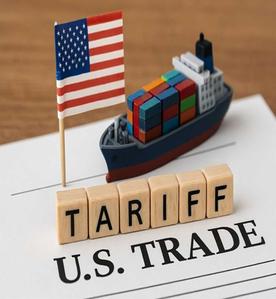U.S. Tariffs and D2C Brands: Pricing Strategy, A/B Test Ideas, and Customer Messaging That Protect Margins
Sector: Digital Commerce
Author: Nisarg Mehta
Date Published: 10/30/2025

Contents
U.S. tariffs are no longer an abstract policy debate, they’re hitting the landed costs and margins of D2C brands across categories. For founders and operators, the question isn’t if you’ll adjust, but how you do it without alienating customers or stalling growth. This playbook walks through the most effective ways D2C brands can survive and even win under tariff pressure: refining pricing strategy, running disciplined A/B tests, diversifying sourcing, and communicating price changes with empathy and transparency. The goal isn’t just protecting margins, but strengthening trust and long-term loyalty when costs rise.
Quick context
Many D2C brands are already responding by raising prices, changing suppliers, and reworking inventory plans, so this is happening at scale and quickly.
1) Tactical options to blunt tariff impact (order = speed → structural)
Short-run: absorb selectively, reprice transparently. Don’t reflexively raise every SKU. Absorb on hero SKUs that drive lifetime value; raise on low-LTV, high-cost SKUs.
Near-run: shift fulfillment or mix. Use bonded warehouses, ship consolidated bulk, or shift some inventory to closer/regional suppliers to dilute per-unit tariff impact.
Medium-run: diversify sourcing + nearshore. Evaluate moving categories to Vietnam/Mexico/domestic OEMs for long-term tariff resilience.
2) Re-thinking price architecture (not just “raise price by X%”)
Adopt tiered pricing by acquisition channel & cohort. Higher CAC channels can tolerate higher AOV (bundle + free-ship), while low-CAC channels keep competitive price.
Shift from single-SKU price to packaged value. Add bundles, subscription options, and versioning (basic / plus / premium) so you can raise perceived value rather than just list prices.
Use dynamic freight/passthroughs sparingly. Instead of “tariff surcharge” line-item (which feels punitive), bake a small percentage into landed cost or present a value-add that offsets the increase (extended warranty, faster returns).
Protect headline price for top-of-funnel units. Keep ad-targeted prices stable; test the increase on back-end channels (email, account pages, repeat-customer offers).
3) A/B testing playbook for pricing + messaging (practical recipes)
Principles first: always power your tests with enough traffic and run by cohort (new vs returning customers). Use conversion rate, AOV, and 30/60/90-day LTV as your main metrics.
Test 1 — Transparent vs bundled price change
- Variant A: Increase SKU price by X% and show a short tooltip: “Due to rising import costs, price updated.”
- Variant B: Keep SKU price but introduce a small bundle (same effective price) or add a free small accessory and announce “new bundle at same price.”
- KPIs: conversion rate, AOV, refund rate, NPS snippets.
Test 2 — Channel-specific price elasticity
- Serve two different prices for the same product by channel (paid social vs email). Measure CAC-to-LTV payback and ROAS.
- KPIs: CAC, ROAS, 30-day repurchase rate.
Test 3 — Shipping & surcharge experiments
- Variant A: Add a small “import fee” line item during checkout.
- Variant B: Include the fee in total and label “landed price” with “no surprises.”
- KPIs: checkout abandonment, completion rate, CS inquiries.
Test 4 — Promotion vs permanent price shift
- Variant A: Increase price permanently (control messaging).
- Variant B: Keep price but use a time-bound discount for early buyers that phases out.
- KPIs: urgency-driven conversion lift, repeat purchase behavior, gross margin per cohort.
Test 5 — Value communication vs feature add
- Variant A: Communicate price increase with an explanation + company POV.
- Variant B: Add product improvements (packaging upgrade / sustainability claim) and present price change as enabling improvement.
- KPIs: sentiment (qualitative), conversion lift, returns.
(For A/B testing best practices and tools, lean on rigorous sample-size calculators, test one primary change per experiment, and avoid running overlapping tests on the same traffic slice.)
4) Measurement & guardrails (don’t wreck LTV chasing short-term margin)
Always read both immediate conversion and 30–90 day cohort behavior. A small dip in immediate conversion may be worth it if retention and AOV improve.
Segment by LTV to decide which cohorts absorb price vs which get offers. New customers are more price sensitive; VIP repeat buyers value convenience and may accept price changes for improved service.
Watch soft signals: support tickets, NPS, mention volume on social — these can be early warning signs that pricing messaging is alienating customers.
5) How to make customers feel included — examples you can use
Tone = human, honest, and benefit-focused. Lead with empathy, then explanation, then value (what they get), and end with options.
Example A — short in-product banner
We want to keep delivering the products you love. Due to higher import costs, our prices have changed slightly. We’ve bundled extra value for you, free 30-day trial for our Care Plan and faster exchanges for any sizing issues. Questions? Our team is here.
Example B — email to VIPs
Hi [Name], you’re one of the customers who’ve supported us from the start, thank you. Starting [date], some prices will change because of new import duties. We wanted you to know first: you’ll get an exclusive 10% window for 7 days, plus free returns for the next 60 days. We’re also investing in better packaging to reduce returns and speed delivery.
Example C — site policy / FAQ
Why prices changed: A small increase helps us keep the same quality, cover higher import duties, and invest in faster local replacements so you don’t wait longer. If you bought in the last 30 days and saw a price change, contact us, we’ll make it right.
Research shows brands who explain why and offer a small immediate benefit (discount, longer returns, gift-with-purchase) preserve trust far better than silent increases.
6) Operational checklist (what to run this week)
- Map landed cost by SKU (tariff component, freight, duty).
- Segment SKUs by LTV contribution and margin sensitivity.
- Prioritize 2–3 A/B tests (pricing, message, bundling). Start with the highest-traffic funnel pages.
- Prepare customer-facing copy + CS scripts (templates for email, FAQ, chat).
- Run a sentiment monitor (Mentions, CS volume) and a small panel survey for qualitative feedback.
- Evaluate nearshore/alt-suppliers for 30–90 day feasibility.
(Quick industry data: most D2C brands are already raising prices or reshaping sourcing; don’t be the last mover.)
Closing — mindset, not panic
Tariffs are a shock to the system, but the best brands use shocks to re-examine unit economics, design richer offers, and deepen relationships. Price increases done right don’t feel like price increases at all; they feel like a continuation of the brand promise. Run small experiments, measure cohort outcomes, and lead with honesty.
FAQs
Q. How are U.S. tariffs impacting D2C brands in 2025?
U.S. tariffs are increasing landed costs and squeezing profit margins for D2C brands across categories. Many brands are responding by adjusting pricing, sourcing from tariff-free regions like Mexico or Vietnam, and redesigning bundles or shipping options to offset extra costs.
Q. What pricing strategies help D2C brands stay profitable under U.S. tariffs?
Top-performing D2C brands use tiered pricing, bundle offers, and selective increases to manage tariff pressure. Instead of blanket price hikes, they protect hero SKUs and adjust low-margin items. Packaging “value upgrades” (like subscriptions or free shipping) also softens the impact of price changes while maintaining customer loyalty.
Q. How can A/B testing help optimize pricing during U.S. tariffs?
A/B testing helps identify the price points and messaging that balance conversion with profit. Brands can test transparent vs bundled pricing, channel-specific prices, or value-added offers to see which version maximizes AOV, retention, and long-term LTV under new cost conditions.
Q. What operational steps can D2C brands take to reduce tariff impact?
Key actions include mapping tariff exposure by SKU, consolidating shipments, using bonded warehouses, exploring nearshoring options, and prioritizing product categories that can absorb minor cost increases without hurting demand.
Q. How are U.S. tariffs reshaping D2C brand profitability in 2025?
U.S. tariffs are directly raising import and production costs, reducing gross margins across D2C categories. To protect profitability, leading brands are adopting smarter pricing architecture, sourcing from low-tariff regions like Vietnam or Mexico, and bundling products to enhance perceived value without aggressive price hikes.
Q. Why choose Techtic as your D2C strategy partner for 2025 and beyond?
Because we’ve helped 50+ global D2C brands thrive through economic shifts by combining data, technology, and empathy-driven strategy. From replatforming to Shopify Plus to optimizing B2B commerce experiences, Techtic empowers brands to grow smarter, faster, and more sustainably, even under tariff pressure.



